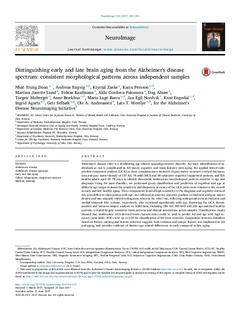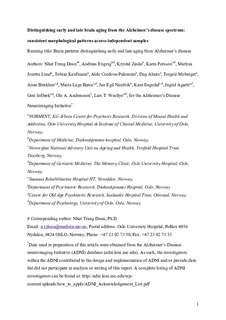| dc.contributor.author | Doan, Nhat Trung | |
| dc.contributor.author | Engvig, Andreas | |
| dc.contributor.author | Zaske, Krystal | |
| dc.contributor.author | Persson, Karin | |
| dc.contributor.author | Lund, Martina Jonette | |
| dc.contributor.author | Kaufmann, Tobias | |
| dc.contributor.author | Còrdova Palomera, Aldo | |
| dc.contributor.author | Alnæs, Dag | |
| dc.contributor.author | Moberget, Torgeir | |
| dc.contributor.author | Brækhus, Anne | |
| dc.contributor.author | Barca, Maria Lage | |
| dc.contributor.author | Nordvik, Jan Egil | |
| dc.contributor.author | Engedal, Knut | |
| dc.contributor.author | Agartz, Ingrid | |
| dc.contributor.author | Selbæk, Geir | |
| dc.contributor.author | Andreassen, Ole Andreas | |
| dc.contributor.author | Westlye, Lars Tjelta | |
| dc.date.accessioned | 2018-10-10T11:32:36Z | |
| dc.date.available | 2018-10-10T11:32:36Z | |
| dc.date.created | 2017-07-12T11:51:19Z | |
| dc.date.issued | 2017 | |
| dc.identifier.citation | NeuroImage. 2017, 158 282-295. | nb_NO |
| dc.identifier.issn | 1053-8119 | |
| dc.identifier.uri | http://hdl.handle.net/11250/2567408 | |
| dc.description.abstract | Abstract
Alzheimer's disease (AD) is a debilitating age-related neurodegenerative disorder. Accurate identification of individuals at risk is complicated as AD shares cognitive and brain features with aging. We applied linked independent component analysis (LICA) on three complementary measures of gray matter structure: cortical thickness, area and gray matter density of 137 AD, 78 mild (MCI) and 38 subjective cognitive impairment patients, and 355 healthy adults aged 18-78 years to identify dissociable multivariate morphological patterns sensitive to age and diagnosis. Using the lasso classifier, we performed group classification and prediction of cognition and age at different age ranges to assess the sensitivity and diagnostic accuracy of the LICA patterns in relation to AD, as well as early and late healthy aging. Three components showed high sensitivity to the diagnosis and cognitive status of AD, with different relationships with age: one reflected an anterior-posterior gradient in thickness and gray matter density and was uniquely related to diagnosis, whereas the other two, reflecting widespread cortical thickness and medial temporal lobe volume, respectively, also correlated significantly with age. Repeating the LICA decomposition and between-subject analysis on ADNI data, including 186 AD, 395 MCI and 220 age-matched healthy controls, revealed largely consistent brain patterns and clinical associations across samples. Classification results showed that multivariate LICA-derived brain characteristics could be used to predict AD and age with high accuracy (area under ROC curve up to 0.93 for classification of AD from controls). Comparison between classifiers based on feature ranking and feature selection suggests both common and unique feature sets implicated in AD and aging, and provides evidence of distinct age-related differences in early compared to late aging. | nb_NO |
| dc.description.sponsorship | The work was supported by the European Commission’s 7th Framework Programme (#602450, IMAGEMEND), Research Council of Norway (213837, 223273, 204966/F20), the South-Eastern Norway Regional Health Authority (2013123, 2014097, 2015073, 2016083), The Norwegian Health Association's Dementia Research Program, and KG Jebsen Foundation. We acknowledge the contribution of patient data from the Norwegian registry for persons being evaluated for cognitive symptoms in specialized care (NorCog) by the Norwegian National Advisory Unit on Ageing and Health. Data collection and sharing for this project was funded by the Alzheimer's Disease Neuroimaging Initiative (ADNI) (National Institutes of Health Grant U01 AG024904) and DOD ADNI (Department of Defense award number W81XWH-12-2-0012). ADNI is funded by the National Institute on Aging, the National Institute of Biomedical Imaging and Bioengineering, and through generous contributions from the following: AbbVie, Alzheimer's Association; Alzheimer's Drug Discovery Foundation; Araclon Biotech; BioClinica, Inc.; Biogen; Bristol-Myers Squibb Company; CereSpir, Inc.; Cogstate; Eisai Inc.; Elan Pharmaceuticals, Inc.; Eli Lilly and Company; EuroImmun; F. Hoffmann-La Roche Ltd and its affiliated company Genentech, Inc.; Fujirebio; GE Healthcare; IXICO Ltd.; Janssen Alzheimer Immunotherapy Research & Development, LLC.; Johnson & Johnson Pharmaceutical Research & Development LLC.; Lumosity; Lundbeck; Merck & Co., Inc.; Meso Scale Diagnostics, LLC.; NeuroRx Research; Neurotrack Technologies; Novartis Pharmaceuticals Corporation; Pfizer Inc.; Piramal Imaging; Servier; Takeda Pharmaceutical Company; and Transition Therapeutics. The Canadian Institutes of Health Research is providing funds to support ADNI clinical sites in Canada. Private sector contributions are facilitated by the Foundation for the National Institutes of Health (www.fnih.org). The grantee organization is the Northern California Institute for Research and Education, and the study is coordinated by the Alzheimer's Therapeutic Research Institute at the University of Southern California. ADNI data are disseminated by the Laboratory for Neuro Imaging at the University of Southern California. | nb_NO |
| dc.language.iso | eng | nb_NO |
| dc.publisher | Elsevier | nb_NO |
| dc.rights | Attribution-NonCommercial-NoDerivatives 4.0 Internasjonal | * |
| dc.rights.uri | http://creativecommons.org/licenses/by-nc-nd/4.0/deed.no | * |
| dc.subject | Alzheimer's disease; | nb_NO |
| dc.subject | Alzheimer's disease spectrum; | nb_NO |
| dc.subject | Early and late aging; | nb_NO |
| dc.subject | Linked independent component analysis; | nb_NO |
| dc.subject | Machine learning; | nb_NO |
| dc.title | Distinguishing early and late brain aging from the Alzheimer's disease spectrum: Consistent morphological patterns across independent samples | nb_NO |
| dc.type | Journal article | nb_NO |
| dc.type | Peer reviewed | nb_NO |
| dc.description.version | acceptedVersion | nb_NO |
| dc.description.version | publishedVersion | nb_NO |
| dc.rights.holder | © 2017 Elsevier Inc. All rights reserved. The Authors.Creative Commons Attribution Non-Commercial No Derivatives License. | nb_NO |
| dc.source.pagenumber | 282-295 | nb_NO |
| dc.source.volume | 158 | nb_NO |
| dc.source.journal | NeuroImage | nb_NO |
| dc.identifier.doi | 10.1016/j.neuroimage.2017.06.070 | |
| dc.identifier.cristin | 1482015 | |
| dc.relation.project | Norges forskningsråd: 249795 | nb_NO |
| dc.relation.project | Helse Sør-Øst RHF: 2015073 | nb_NO |
| dc.relation.project | Helse Sør-Øst RHF: 2014097 | nb_NO |
| cristin.unitcode | 1991,9,1,0 | |
| cristin.unitname | Avd Alderspsykiatri | |
| cristin.ispublished | true | |
| cristin.fulltext | original | |
| cristin.fulltext | postprint | |
| cristin.qualitycode | 2 | |


